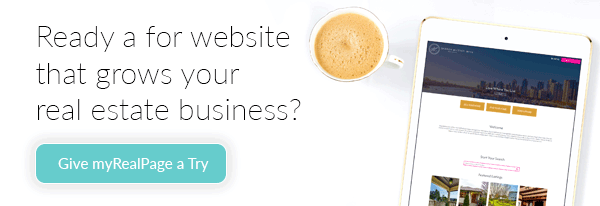A How-To Guide to Successful Real Estate Branding

What would Coca-Cola be without its signature red hue, cursive logo and iconic glass bottle? It would be a soda maker.
What would Apple be without its bitten apple icon, sleek shapes and silvery palette? It would be a technology company.
What would McDonald’s be without its arches, “I’m lovin’ it” slogan and red-and-yellow colour combination? It would be a fast food restaurant.
Instead, Coca-Cola, Apple and McDonald’s are three of the most iconic companies in the world — e.g. not just a soda maker, but the soda maker.
Why? Because they established rock-solid branding that people came to recognize, trust and associate with things like taste, quality and convenience.
Thanks to those positive associations — e.g., bitten apple = Apple = quality — these brands have built huge and loyal customer bases that grow by the day.
Imagine you could do the same for your real estate company?
Okay, so you’re probably not going to grow your business into a multinational real estate corporation.
But you can turn it into an instantly recognizable local real estate company that your target market associates with professionalism, trustworthiness and results.
The trick = brand your real estate business.
If you’re just starting out in real estate, it’s a perfect time to brand your business. And if you’ve been in the industry for years, don’t worry — it’s never too late to start.
Here’s what REALTORS® need to know about branding and how you can establish real estate branding that gets noticed and gets results.
Why Branding Matters
A brand is what you do. What you offer. Apple’s brand is laptops and smartphones. A real estate agent’s brand is their expertise and buying and selling services.
Branding is how you present your brand to the world. It includes your logo, the colours you use, and how your messaging sounds.
Branding matters because it represents your brand in the market. It’s how people — how your target audience — perceive what it is that you do. It’s both a first impression and a lasting impression.
Ineffective branding doesn’t properly communicate what’s great about your brand. Effective branding sells the sizzle; it makes people sit up and pay attention to what you do.
Zero In on Your Target Market
In order to create effective branding, you need to hone in on who’s on the receiving end.
Translation: who are you marketing to?
You need to know which target real estate market(s) you’re trying to reach in order to develop branding that they’ll be receptive to.
For example:
If your target market is millennials and first-time buyers, your branding might be modern and bright with design-y fonts and a laidback, very conversational voice and tone.
If your target market is baby boomers and empty-nesters, your branding might be clean and sophisticated, with a more classic look and a professional yet approachable voice and tone.
Define Your Colour Palette
This might seem like an odd first step when it comes to developing a visual identity for your real estate brand, but it helps lay the foundation for everything else — like your logo, photography and iconography (the images and symbols you’ll use in your marketing materials).
It’s not as simple as picking your favourite colour and thinking about what colours might go well with it.
You need to consider:
- What emotions are associated with certain colours. What feelings do certain colours evoke?
- What your competitors are doing. Branding is supposed to help set you apart. Research your competitors and take note of their palettes.
- Your target market. Baby boomers might not go for a light-pink-and-green palette, but millennials might appreciate it.
- How colours will work together. A visual identity requires many colours. They serve as accents, backgrounds, dominant colours and secondary colours. When choosing a palette, you need to consider how your desired hues will interact.
- How your palette will work in situ. A selection of colours might look amazing together when grouped on a screen, but when they’re in context — on your website, in your ads and so on — they might not work. They could look too bright, or nearly invisible on a white background. You need to test, test, test.
Defining your real estate colour palette is important, but it doesn’t have to be intimidating. This in-depth guide from 99designs offers easy-to-understand tips from the perspective of a designer — super helpful.
Create a Logo
A logo isn’t the be-all and end-all of your real estate branding. But it is an important element.
Your logo will appear on your real estate website, your business cards, your real estate Facebook Ads, your postcards, your open house marketing and many other places. It needs to be eye-catching and, most importantly, unique.
It should be consistent with your brand colours, as well as simple and clean; anything too detailed runs the risk of being indecipherable when it’s scaled down for things like business cards or website icons.
While many logos feature a symbol or image with little to no text, we strongly recommend that real estate agents include their name in their logo. Your name is your business, and you need your target market to recognize it.
Does all this mean you need to design your logo yourself? Of course not. This is an area of your business that you should trust to a professional.
If you know a graphic designer you’d like to work with, great. If not, turn to online freelance platforms like Upwork, Fiverr or the aforementioned 99designs. Post your project and start virtually collaborating with a freelance designer.
Determine Your Visual Style
There’s more to the visual part of your real estate branding than just your colour palette and logo.
There’s your overall visual style, too. It includes things like:
- the specific fonts and styles you use for headlines, subheadings and body text;
- the kinds of real estate photos you use in your marketing materials and social media (e.g. light and bright, or slightly moodier and dramatic);
- the icons on your website (e.g. round and playful, or angular and modern); and
- the graphic design styles that appear on any marketing materials you produce (e.g. clean, with minimalist lines; luxe, with flourishes and antique touches; or organic, with handmade-like details).
Researching your competitors and combing through design websites like Dribbble and Behance are a good starting point for recognizing what you like and what you don’t like.
Remember that your visual style should be strongly aligned with the general tastes and aesthetic of your target market. It also needs to work seamlessly with your color palette and logo. Strong branding is cohesive branding.
Establish Your Voice and Tone
While so much of branding is visual, how your brand sounds is just as important. Meaning, how you communicate via your website, your social media platforms, your video content and your advertising. This is your brand voice and tone.
Your brand voice is your personality. It’s completely unique to you, like a fingerprint. It never changes, no matter what platform it appears on.
Think about how you’d always like to sound to your audience. Maybe it’s “warm, funny and helpful.” Maybe it’s “authoritative, insightful and driven.” Picking three adjectives is an excellent way of honing in on your voice.
Your brand tone changes depending on who you’re addressing, what you’re speaking about and where you’re doing the communicating. For example, your tone in an Instagram caption about home decor fails might be slightly sarcastic, whereas your tone in a client thank-you card will be appreciative.
Implement and Be Consistent
Once you’ve got these elements finalized, it’s time to start rolling out your identity.
Here’s a list of places and platforms where you’ll need to implement your branding:
- Your real estate website
- All your social media channels
- Your print materials (including postcards)
- Your business card
- Your letterhead, contracts and other document templates
- Your email signature
- Your digital ads
The most important thing — more crucial than anything else in this guide — is consistency. You need to be consistent when using your branding.
That’s how your target market will begin to recognize your branding and develop positive associations with your brand. It’s how brands become strong.
Make sure your logo is never cropped or distorted. That you’re sticking to your colour palette. That your brand voice remains the same in all contexts. And that your visual style is identifiable everywhere from your website to your Instagram grid.
Want help staying consistent? Create your own brand guide. This is a document where you outline all the rules and best practices for using your logo, colours, fonts, icons, photography, and voice and tone. Keep it handy to refer to when you’re creating new content or updating your website.
Have you developed personalized branding for your real estate business?
Last Updated on June 27, 2024 by myRealPage


